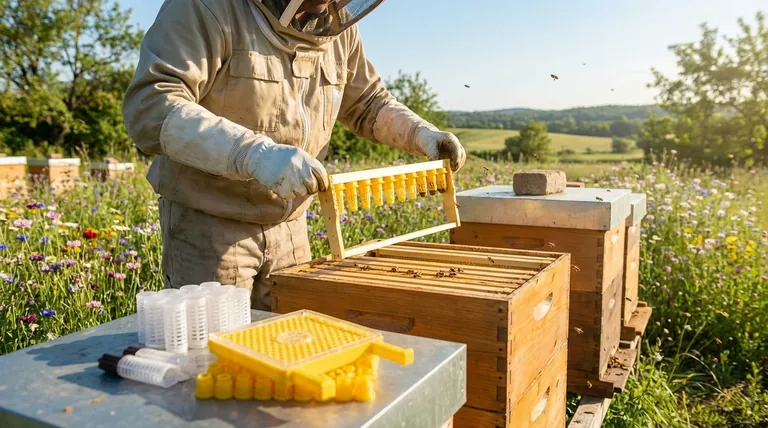The ideal field conditions for rearing high-quality queen bees are a light nectar flow combined with a strong, diverse pollen flow. This environment is most common during the natural swarming season. Critically, you must avoid attempting to rear queens during a heavy honey flow, as it shifts the colony's priorities away from queen production.
The core principle is not to overwhelm the bees with resources, but to simulate the precise biological triggers for colony reproduction. A light nectar flow signals growth, while abundant pollen provides the essential protein to build large, well-fed queens.

The Principle: Simulating the Swarm Impulse
Successful queen rearing involves manipulating a colony's natural reproductive drive. The best external conditions are those that mimic the environment that would naturally cause a colony to swarm and create new queens.
Why a Light Nectar Flow is Critical
A gentle, consistent flow of incoming nectar signals to the bees that resources are available and the colony can afford to expand. This encourages the production of royal jelly and focuses the nurse bees' attention on caring for developing larvae, including potential queens.
Why a Heavy Honey Flow is Detrimental
A massive influx of nectar triggers a different instinct: food storage. The colony's focus shifts entirely to collecting, processing, and storing honey. Nurse bees are often diverted to these tasks, queen cells may be neglected, and the colony's impulse to rear a new queen diminishes significantly.
The Role of Abundant, Diverse Pollen
Pollen is the sole source of protein, fats, and minerals for the colony. It is the primary ingredient in royal jelly. A strong and varied pollen supply ensures nurse bees can produce copious amounts of high-quality royal jelly, which is essential for developing large, well-fed, and ultimately more prolific queens.
Timing with the Swarming Season
Aligning your queen rearing efforts with the natural swarming season places you in sync with the bees' biology. During this time, colonies are already primed to raise new queens, making them far more receptive to the cells you introduce.
Understanding the Trade-offs and Nuances
While ideal conditions make the process easier and more reliable, it's crucial to understand the variables you can control.
The "Goldilocks" Zone of Resources
Queen rearing fails in two opposite scenarios. A nectar dearth means the colony is in survival mode and will not invest in new queens. A heavy honey flow means the colony is in storage mode. The ideal is the "just right" flow that signals growth and prosperity.
The Importance of the Cell Builder Colony
Field conditions are only half the equation. The colony chosen to build the queen cells—the cell builder—must be strong, populous, and overflowing with young nurse bees. Even in perfect weather, a weak colony will produce poor-quality queens or fail entirely.
Rearing in Sub-Optimal Conditions
It is possible to rear queens when field conditions are not perfect, but it requires intervention. If there is no nectar flow or pollen is scarce, you must provide supplemental feeding with 1:1 sugar syrup and a high-quality pollen substitute to simulate the ideal resource environment.
Making the Right Choice for Your Goal
Your strategy should adapt to the conditions you are facing.
- If your primary focus is leveraging ideal conditions: Concentrate your efforts during the swarming season when a light nectar flow and strong pollen are naturally present. This is your highest probability for success.
- If your primary focus is rearing during a heavy honey flow: You must take steps to mitigate the flow's impact, such as moving your cell builder to a less productive location or creating artificial swarm conditions within the hive.
- If your primary focus is rearing during a dearth: Success is entirely dependent on your ability to provide consistent supplemental feeding of both sugar syrup and pollen to trick the colony into a state of growth.
By understanding and recreating these key biological triggers, you move from simply raising queens to cultivating exceptional ones.
Summary Table:
| Condition | Role in Queen Rearing |
|---|---|
| Light Nectar Flow | Signals colony growth, encourages royal jelly production. |
| Abundant, Diverse Pollen | Provides protein for high-quality royal jelly to build large queens. |
| Swarming Season Timing | Aligns with the colony's natural reproductive drive. |
| Avoid Heavy Honey Flow | Shifts colony focus to food storage, away from queen rearing. |
Ready to Elevate Your Queen Rearing Operation?
Successful queen production relies on superior beekeeping equipment. Whether you are a commercial apiary scaling up production or a distributor supplying the industry, HONESTBEE provides the durable, efficient tools you need to succeed.
We supply wholesale-focused beekeeping supplies and equipment designed for professional results. Let's discuss how our solutions can support your goals.
Contact HONESTBEE today for a quote!
Visual Guide

Related Products
- Jenter Queen Rearing Kit Complete Set for Bee Breeding
- Nicot Queen Rearing Kit for Beekeeping and Grafting in Nicot System
- No Grafting Queen Rearing Kit: System for Royal Jelly Production and Queen Rearing
- Plastic Chinese Queen Grafting Tool for Bee Queen Rearing
- Retractable Chinese Queen Rearing Grafting Tools Equipment
People Also Ask
- What is the timeline for queen breeding? A 28-Day Guide from Egg to Laying Queen
- What are the stages involved in queen raising? A Guide to Controlled, High-Quality Queen Production
- How long does it take for a new queen to emerge, mate, and lay eggs? A Beekeeper's 10-14 Day Guide
- What were the size differences among queens reared from worker larvae? Maternal Origin Determines Queen Size
- What genetic pathways differ in QE-queens? Unlocking the Master Controls of Queen Bee Biology



















